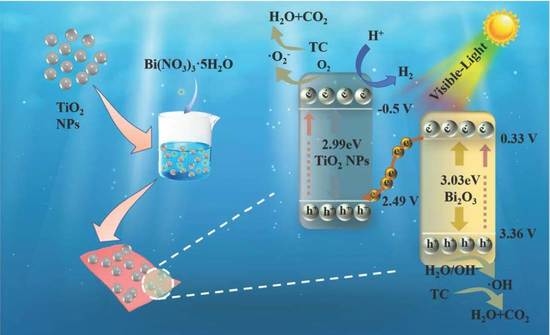Constructing Z-Scheme 0D/2D TiO2 Nanoparticles/Bi2O3 Nanosheet Heterojunctions with Enhanced Visible Light Induced Photocatalytic Antibiotics Degradation and Hydrogen Evolution
Abstract
:1. Introduction
2. Results and Discussion
2.1. Morphology and Structure
2.2. Optical Properties
2.3. Photoluminescence and Photoelectrochemical Analysis
2.4. Photocatalytic Activities
2.5. Discussion on Photocatalytic Mechanisms
3. Materials and Methods
3.1. Synthesis of TiO2 NPs/Bi2O3 Composites
3.2. Photocatalytic Performance Measurements
4. Conclusions
Supplementary Materials
Author Contributions
Funding
Data Availability Statement
Conflicts of Interest
References
- Ismael, M. Environmental remediation and sustainable energy generation via photocatalytic technology using rare earth metals modified g-C3N4. J. Alloys Compd. 2023, 931, 167469. [Google Scholar] [CrossRef]
- Cheng, L.; Xiang, Q.-J.; Liao, Y.-L.; Zhang, H.-W. CdS-Based photocatalysts. Energy Environ. Sci. 2018, 11, 1362–1391. [Google Scholar] [CrossRef]
- Li, P.; Wang, Y.; Huang, B.; Guan, S.; Luan, T.; Lin, G.; Yuan, K. Antibiotics in wastewater of Guangdong, China: Distribution patterns, and their environmental risk due to incomplete removal. Sci. Total Environ. 2022, 849, 157889. [Google Scholar] [CrossRef] [PubMed]
- Imwene, K.-O.; Ngumba, E.; Kairigo, P.-K. Emerging technologies for enhanced removal of residual antibiotics from source-separated urine and wastewaters: A review. J. Environ. Manag. 2022, 322, 116065. [Google Scholar] [CrossRef] [PubMed]
- Mishra, R.; Bera, S.; Chatterjee, R.; Banerjee, S.; Bhattacharya, S.; Biswas, A.; Mallick, S.; Roy, S. A review on Z/S–scheme heterojunction for photocatalytic applications based on metal halide perovskite materials. Appl. Surf. Sci. 2022, 9, 100241. [Google Scholar] [CrossRef]
- Li, H.; Deng, F.; Zheng, Y.; Hua, L.; Qu, C.-H.; Luo, X.-B. Visible-light-driven Z-scheme rGO/Bi2S3-BiOBr heterojunctions with tunable exposed BiOBr (102) facets for efficient synchronous photocatalytic degradation of 2-nitrophenol and Cr(VI) reduction. Environ. Sci. Nano 2019, 6, 3670–3683. [Google Scholar] [CrossRef]
- Derikvandi, H.; Nezamzadeh-Ejhieh, A. An effective wastewater treatment based on sunlight photodegradation by SnS2 ZnS/clinoptilolite composite. Solid State Sci. 2020, 101, 106127. [Google Scholar] [CrossRef]
- Yuan, Y.; Guo, R.-T.; Hong, L.-F.; Ji, X.-Y.; Lin, Z.-D.; Li, Z.-S.; Pan, W.-G. A review of metal oxide-based Z-scheme heterojunction photocatalysts: Actualities and developments. Mater. Today Energy 2021, 21, 100829. [Google Scholar] [CrossRef]
- Xia, B.; Deng, F.; Zhang, S.; Hua, L.; Luo, X.; Ao, M. Design and synthesis of robust Z-scheme ZnS-SnS2 n-n heterojunctions for highly efficient degradation of pharmaceutical pollutants: Performance, valence/conduction band offset photocatalytic mechanisms and toxicity evaluation. J. Hazard. Mater. 2020, 392, 122345. [Google Scholar] [CrossRef]
- Jia, T.; Wu, J.; Xiao, Y.; Liu, Q.; Wu, Q.; Qi, Y.; Qi, X. Self-grown oxygen vacancies-rich CeO2/BiOBr Z-scheme heterojunction decorated with rGO as charge transfer channel for enhanced photocatalytic oxidation of elemental mercury. J. Colloid Interface Sci. 2021, 587, 402–416. [Google Scholar] [CrossRef]
- Jiang, T.; Wang, K.; Guo, T.; Wu, X.; Zhang, G. Fabrication of Z-scheme MoO3/Bi2O4 heterojunction photocatalyst with enhanced photocatalytic performance under visible light irradiation. Chin. J. Catal. 2020, 41, 161–169. [Google Scholar] [CrossRef]
- Li, Y.; Yu, B.; Liu, B.; Yu, X.; Qin, G.; Fan, M.; Zhang, Y.; Wang, L. Superior Fenton-like and photo-Fenton-like activity of MoS2@ TiO2/N-doped carbon nanofibers with phase-regulated and vertically grown MoS2 nanosheets. Chem. Eng. J. 2023, 452, 139542. [Google Scholar] [CrossRef]
- Farghali, A.-A.; Zaki, A.-H.; Khedr, M.-H. Control of Selectivity in Heterogeneous Photocatalysis by Tuning TiO2 Morphology for Water Treatment Applications. Nanomater. Nanotechnol. 2016, 6, 12. [Google Scholar] [CrossRef]
- Ma, Z.-Y.; Deng, L.-J.; Li, X.-B.; Fan, G. Preparation of TiO2/Bi2O3 Microfibers and Their Photocatalytic Activity. Chin. J. Chem. Phys. 2014, 27, 439–444. [Google Scholar] [CrossRef]
- Wang, Y.; Zhao, S.-Z.; Yang, Y.; Rodriguez, R.-D.; Lipovka, A.; Lu, Y.; Huang, H.-L.; Chen, J.-J. Ag nanoparticle-decorated Bi2O3-TiO2 heterogeneous nanotubular photocatalysts for enhanced degradation of organic contaminants. Colloids Surf. A Physicochem. Eng. Asp. 2022, 648, 129233. [Google Scholar] [CrossRef]
- Xu, C.; Zhou, Q.; Huang, W.-Y.; Yang, K.; Zhang, Y.-C.; Liang, T.-X.; Liu, Z.-Q. Constructing Z-scheme β-Bi2O3/ZrO2 heterojunctions with 3D mesoporous SiO2 nanospheres for efficient antibiotic remediation via synergistic adsorption and photocatalysis. Rare Met. 2022, 41, 2094–2107. [Google Scholar] [CrossRef]
- Liu, Z.; Wang, Q.; Tan, X.; Zheng, S.; Zhang, H.; Wang, Y.; Gao, S. Solvothermal preparation of Bi/Bi2O3 nanoparticles on TiO2 NTs for the enhanced photoelectrocatalytic degradation of pollutants. J. Alloys Compd. 2020, 815, 152478. [Google Scholar] [CrossRef]
- Ke, T.; Shen, S.; Yang, K.; Lin, D. In situ fabrication of Bi2O3/C3N4/TiO2@C photocatalysts for visible-light photodegradation of sulfamethoxazole in water. Appl. Surf. Sci. 2022, 580, 152302. [Google Scholar] [CrossRef]
- Zhao, Z.-T.; Wang, N.; Zhang, H.; Shang, R.-M.; Xing, J.-J.; Zhang, D.; Li, J.-H. Fabrication of ZSM-5 zeolite supported TiO2-NiO heterojunction photocatalyst and research on its photocatalytic performance. J. Solid State Chem. 2022, 309, 122895. [Google Scholar] [CrossRef]
- Liu, X.-H.; Kang, Y.; Wang, Y. Novel high-efficiency visible-light-driven p-n heterojunction β-Bi2O3/Ag2WO4 photocatalysts. Chem. Phys. Lett. 2022, 790, 139347. [Google Scholar] [CrossRef]
- Zhang, X.; Xu, G.; Hu, J.; Lv, J.; Wang, J.; Wu, Y. Fabrication and photocatalytic performances of BiOCl nanosheets modified with ultrafine Bi2O3 nanocrystals. RSC Adv. 2016, 6, 63241–63249. [Google Scholar] [CrossRef]
- Liu, H.; Luo, M.; Hu, J.; Zhou, T.; Chen, R.; Li, J. β-Bi2O3 and Er3+ doped β-Bi2O3 single crystalline nanosheets with exposed reactive {001} facets and enhanced photocatalytic performance. Appl. Catal. B 2013, 140–141, 141–150. [Google Scholar] [CrossRef]
- Ding, C.-K.; Qin, X.-W.; Tian, Y.-Y.; Cheng, B.-W. PES membrane surface modification via layer-by-layer self-assembly of GO@TiO2 for improved photocatalytic performance. J. Membr. Sci. 2022, 659, 120789. [Google Scholar] [CrossRef]
- Han, Z.-Z.; Wei, L.-Y.; Pan, H.-B.; Li, C.-Y.; Chen, J.-H. Variant effect of graphene sheets and ribbons on photocatalytic activity of TiO2 sheets/graphene composite. J. Mol. Catal. A Chem. 2015, 398, 399–406. [Google Scholar] [CrossRef]
- Hu, L.-M.; Dong, S.-Y.; Li, Q.-L.; Feng, J.-L.; Pi, Y.-Q.; Liu, M.-L.; Sun, J.-Y.; Sun, J.-H. Facile synthesis of BiOF/Bi2O3/reduced graphene oxide photocatalyst with highly efficient and stable natural sunlight photocatalytic performance. J. Alloys Compd. 2015, 633, 256–264. [Google Scholar] [CrossRef]
- Zou, H.; Song, M.-X.; Yi, F.-C.; Bian, L.; Liu, P.; Zhang, S. Simulated-sunlight-activated photocatalysis of Methyl Orange using carbon and lanthanum co-doped Bi2O3–TiO2 composite. J. Alloys Compd. 2016, 680, 54–59. [Google Scholar] [CrossRef]
- Gao, X.-M.; Shang, Y.-Y.; Liu, L.-B.; Gao, K.-L. Ag plasmon resonance promoted 2D AgBr-δ-Bi2O3 nanosheets with enhanced photocatalytic ability. J. Alloys Compd. 2019, 803, 565–575. [Google Scholar] [CrossRef]
- Rongan, H.; Haijuan, L.; Huimin, L.; Difa, X.; Liuyang, Z. S-scheme photocatalyst Bi2O3/TiO2 nanofiber with improved photocatalytic performance. J. Mater. Sci. Technol. 2020, 52, 145–151. [Google Scholar] [CrossRef]
- Hu, J.-D.; Xie, J.; Jia, W.; Zhang, S.; Wang, S.-Q.; Wang, K.; Cao, Y.-L. Interesting molecule adsorption strategy induced energy band tuning: Boosts 43 times photocatalytic Water splitting ability for commercial TiO2. Appl. Catal. B 2020, 268, 118753. [Google Scholar] [CrossRef]
- Limpachanangkul, P.; Liu, L.; Hunsom, M.; Piumsomboon, P.; Chalermsinsuwan, B. Application of Bi2O3/TiO2 heterostructures on glycerol photocatalytic oxidation to chemicals. Energy Reports 2022, 8, 1076–1083. [Google Scholar] [CrossRef]
- Li, L.; Dai, H.; Feng, L.; Luo, D.; Wang, S.; Sun, X. Enhance photoelectrochemical hydrogen-generation activity and stability of TiO2 nanorod arrays sensitized by PbS and CdS quantum dots under UV-visible light. Nanoscale Res. Lett. 2015, 10, 418. [Google Scholar] [CrossRef] [PubMed]
- Pan, D.-L.; Han, Z.-Y.; Miao, Y.-C.; Zhang, D.-Q.; Li, G.-S. Thermally stable TiO2 quantum dots embedded in SiO2 foams: Characterization and photocatalytic H2 evolution activity. Appl. Catal. B 2018, 229, 130–138. [Google Scholar] [CrossRef]
- Ren, C.-J.; Qiu, W.; Zhang, H.-L.; He, Z.-J.; Chen, Y.-Q. Degradation of benzene on TiO2/SiO2/Bi2O3 photocatalysts under UV and visible light. J. Mol. Catal. A Chem. 2015, 398, 215–222. [Google Scholar] [CrossRef]
- Liu, Y.; Wei, J.-H.; Xiong, R.; Pan, C.-X.; Shi, J. Enhanced visible light photocatalytic properties of Fe-doped TiO2 nanorod clusters and monodispersed nanoparticles. Appl. Surf. Sci. 2011, 257, 8121–8126. [Google Scholar] [CrossRef]
- Jiang, Y.-B.; Sun, Z.-Z.; Chen, Q.-W.; Cao, C.; Zhao, Y.; Yang, W.-S.; Zeng, L.; Huang, L.-M. Fabrication of 0D/2D TiO2 Nanodots/g-C3N4 S-scheme heterojunction photocatalyst for efficient photocatalytic overall water splitting. Appl. Surf. Sci. 2022, 571, 151287. [Google Scholar] [CrossRef]
- Zhou, Q.; Huang, W.-Y.; Xu, C.; Liu, X.; Yang, K.; Li, D.; Hou, Y.; Dionysiou, D.-D. Novel hierarchical carbon quantum dots-decorated BiOCl nanosheet/carbonized eggshell membrane composites for improved removal of organic contaminants from water via synergistic adsorption and photocatalysis. Chem. Eng. J. 2021, 420, 129582. [Google Scholar] [CrossRef]
- Li, J.; Yuan, H.; Zhu, Z. Improved photoelectrochemical performance of Z-scheme g-C3N4/Bi2O3/BiPO4 heterostructure and degradation property. Appl. Surf. Sci. 2016, 385, 34–41. [Google Scholar] [CrossRef]
- Liu, X.; Xu, Y.; Jiang, Y.; Song, M.; Liu, Z.; Guo, W.; You, L.; Wu, J.; Xu, M.; He, Y. Nanoarchitectonics of uniformly distributed noble-metal-free CoP in g-C3N4 via in-situ fabrication for enhanced photocatalytic and electrocatalytic hydrogen production. J. Alloys Compd. 2022, 904, 163861. [Google Scholar] [CrossRef]
- Huang, W.; Tan, Y.; Zhang, C.; Zhou, Q.; Yang, K.; Zhang, Y.; Li, D.; Dionysiou, D.D. In situ decoration of La(OH)3 on polyethyleneimine-linked dendritic mesoporous silica nanospheres targeting at efficient and simultaneous removal of phosphate and Congo red. Environ. Sci. Nano 2021, 8, 3792–3805. [Google Scholar] [CrossRef]
- Wang, W.; Xiao, K.; Zhu, L.; Yin, Y.; Wang, Z. Graphene oxide supported titanium dioxide & ferroferric oxide hybrid, a magnetically separable photocatalyst with enhanced photocatalytic activity for tetracycline hydrochloride degradation. RSC Adv. 2017, 7, 21287–21297. [Google Scholar]
- Che, H.; Chen, J.; Huang, K.; Hu, W.; Hu, H.; Liu, X.; Che, G.; Liu, C.; Shi, W. Construction of SrTiO3/Bi2O3 heterojunction towards to improved separation efficiency of charge carriers and photocatalytic activity under visible light. J. Alloys Compd. 2016, 688, 882–890. [Google Scholar] [CrossRef]
- Thanh Tung, M.-H.; Dieu Cam, N.-T.; Van Thuan, D.; Van Quan, P.; Van Hoang, C.; Thu Phuong, T.-T.; Lam, N.-T.; Tam, T.-T.; Phuong Le Chi, N.-T.; Lan, N.-T.; et al. Novel direct Z-scheme AgI/N–TiO2 photocatalyst for removal of polluted tetracycline under visible irradiation. Ceram. Int. 2020, 46, 6012–6021. [Google Scholar] [CrossRef]
- Zhang, S.; Yin, Z.; Xie, L.; Yi, J.; Tang, W.; Tang, T.; Chen, J.; Cao, S. Facet engineered TiO2 hollow sphere for the visible-light-mediated degradation of antibiotics via ligand-to-metal charge transfer. Ceram. Int. 2020, 46, 8949–8957. [Google Scholar] [CrossRef]
- Shi, Y.; Yan, Z.; Xu, Y.; Tian, T.; Zhang, J.; Pang, J.; Peng, X.; Zhang, Q.; Shao, M.; Tan, W.; et al. Visible-light-driven AgBr–TiO2-Palygorskite photocatalyst with excellent photocatalytic activity for tetracycline hydrochloride. J. Clean. Prod. 2020, 277, 124021. [Google Scholar] [CrossRef]
- Tan, Y.; Zhou, Q.; Huang, W.; Lu, K.; Yang, K.; Chen, X.; Li, D.; Dionysiou, D.-D. Highly efficient photocatalytic degradation over rose-like 1D/2D La(OH)3/(BiO)2OHCl heterostructures boosted by rich oxygen vacancies and enhanced interfacial charge transfer. Environ. Sci. Nano 2023, 10, 215–228. [Google Scholar] [CrossRef]
- Sun, H.; Xiao, Z.; Zhao, Z.; Huang, Y.; Zhai, S.; An, Q. Facile synthesis of CaWO4 nanoparticles incorporated on porous carbons with improved photocatalytic degradation of tetracycline. Colloids Surf. A Physicochem. Eng. Asp. 2022, 651, 129790. [Google Scholar] [CrossRef]
- Chen, P.; Dong, N.; Zhang, J.; Wang, W.; Tan, F.; Wang, X.; Qiao, X.; Keung Wong, P. Investigation on visible-light photocatalytic performance and mechanism of zinc peroxide for tetracycline degradation and Escherichia coli inactivation. J. Colloid Interface Sci. 2022, 624, 137–149. [Google Scholar] [CrossRef]
- Li, D.; Liu, Y.; Yang, Y.; Tang, G.; Tang, H. Rational construction of Ag3PO4/WO3 step-scheme heterojunction for enhanced solar-driven photocatalytic performance of O2 evolution and pollutant degradation. J. Colloid Interface Sci. 2022, 608, 2549–2559. [Google Scholar] [CrossRef]
- Cheng, L.; Xie, M.; Sun, Y.; Liu, H. Bi2WO6-wrapped 2D Ni-MOF sheets with significantly improved photocatalytic activity by a direct Z-scheme electron transfer. J. Alloys Compd. 2022, 896, 163055. [Google Scholar] [CrossRef]
- Guo, Y.-C.; Yan, B.-G.; Deng, F.; Shao, P.-S.; Zou, J.-P.; Luo, X.-B.; Zhang, S.-Q.; Li, X.-B. Lattice expansion boosting photocatalytic degradation performance of CuCo2S4 with an inherent dipole moment. Chin. Chem. Lett. 2023, 34, 107468. [Google Scholar]
- Li, Y.-L.; Han, X.-J.; Hou, Y.-Q.; Guo, Y.-P.; Liu, Y.-J.; Xiang, N.; Cui, Y.; Huang, Z.-G. In situ preparation of mesoporous Fe/TiO2 catalyst using Pluronic F127-assisted sol-gel process for mid-temperature NH3 selective catalytic reduction. Chin. J. Catal. 2017, 38, 1831–1841. [Google Scholar] [CrossRef]
- Huang, G.; He, J.-X.; Zhang, X.; Feng, M.-M.; Tan, Y.; Lv, C.-C.; Huang, H.; Jin, Z. Applications of Lambert-Beer law in the preparation and performance evaluation of graphene modified asphalt. Constr. Build. Mater. 2021, 273, 121582. [Google Scholar] [CrossRef]
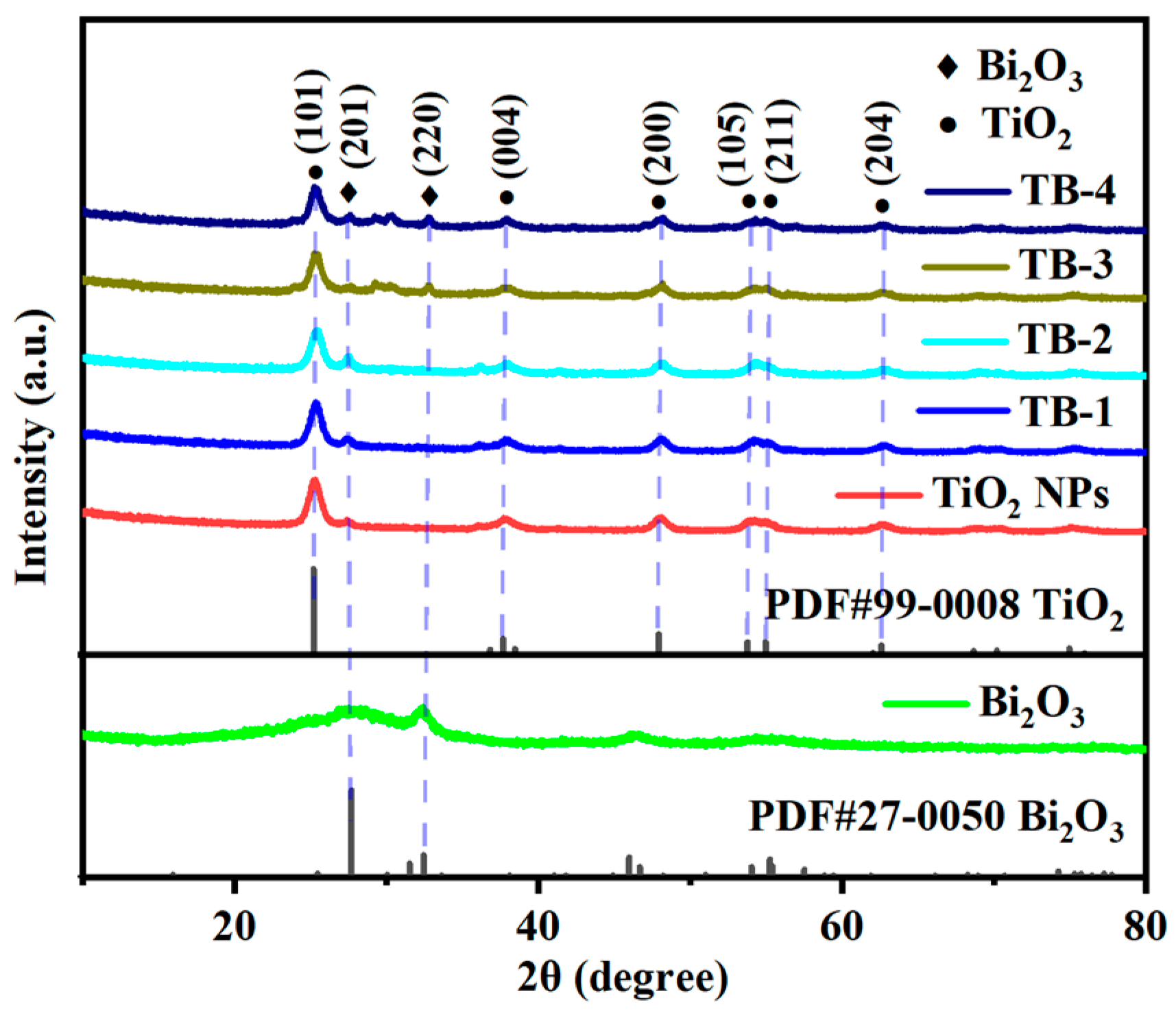
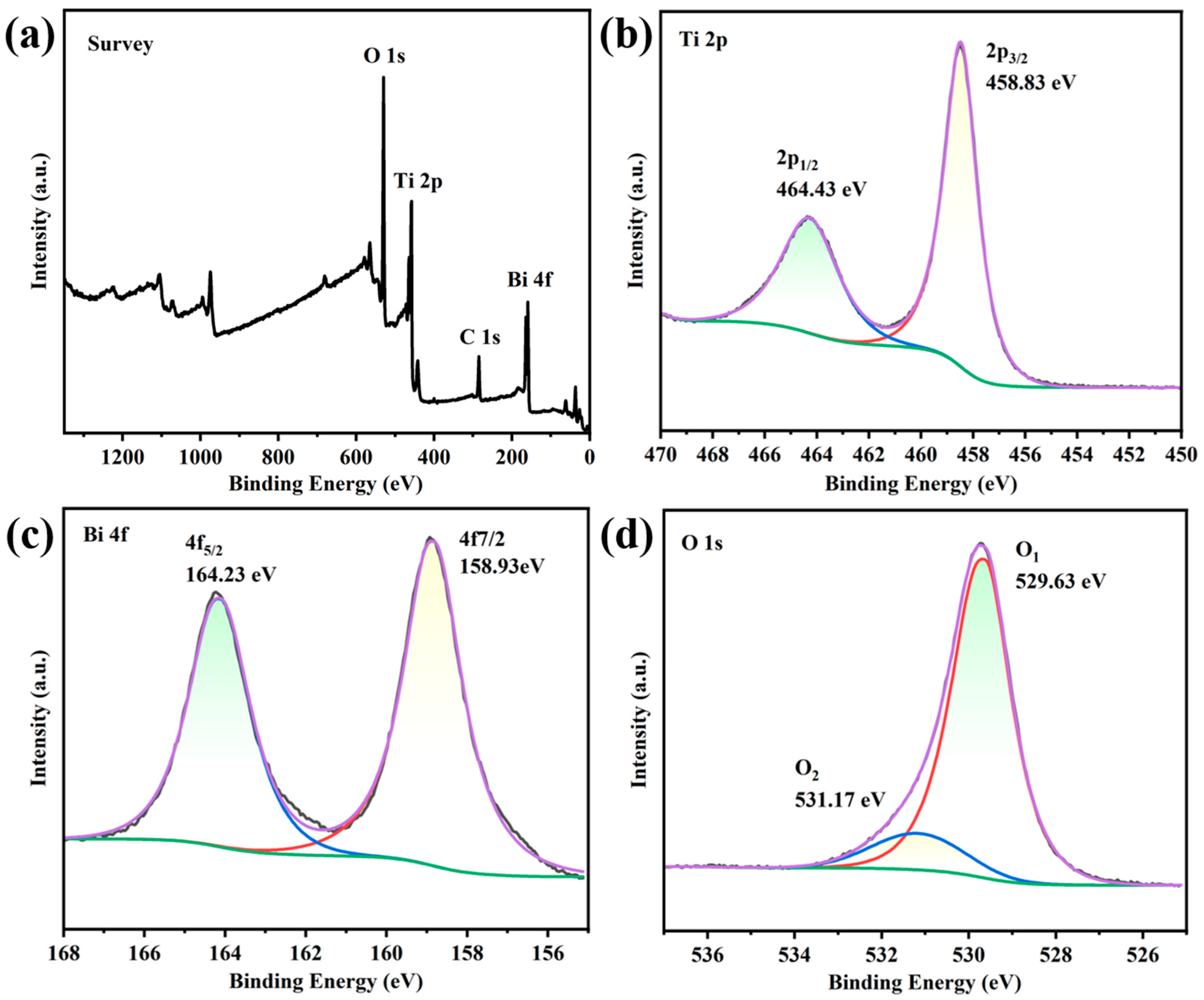
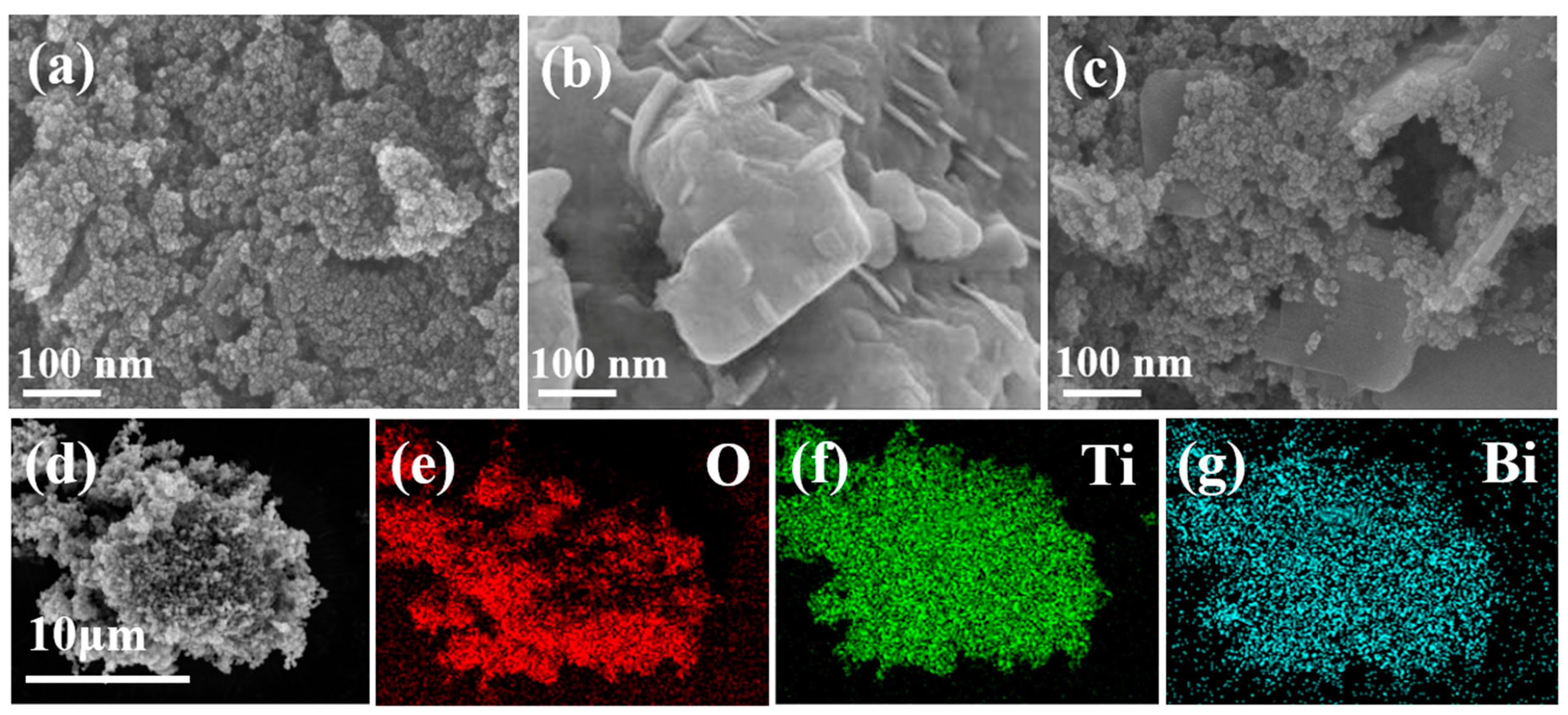
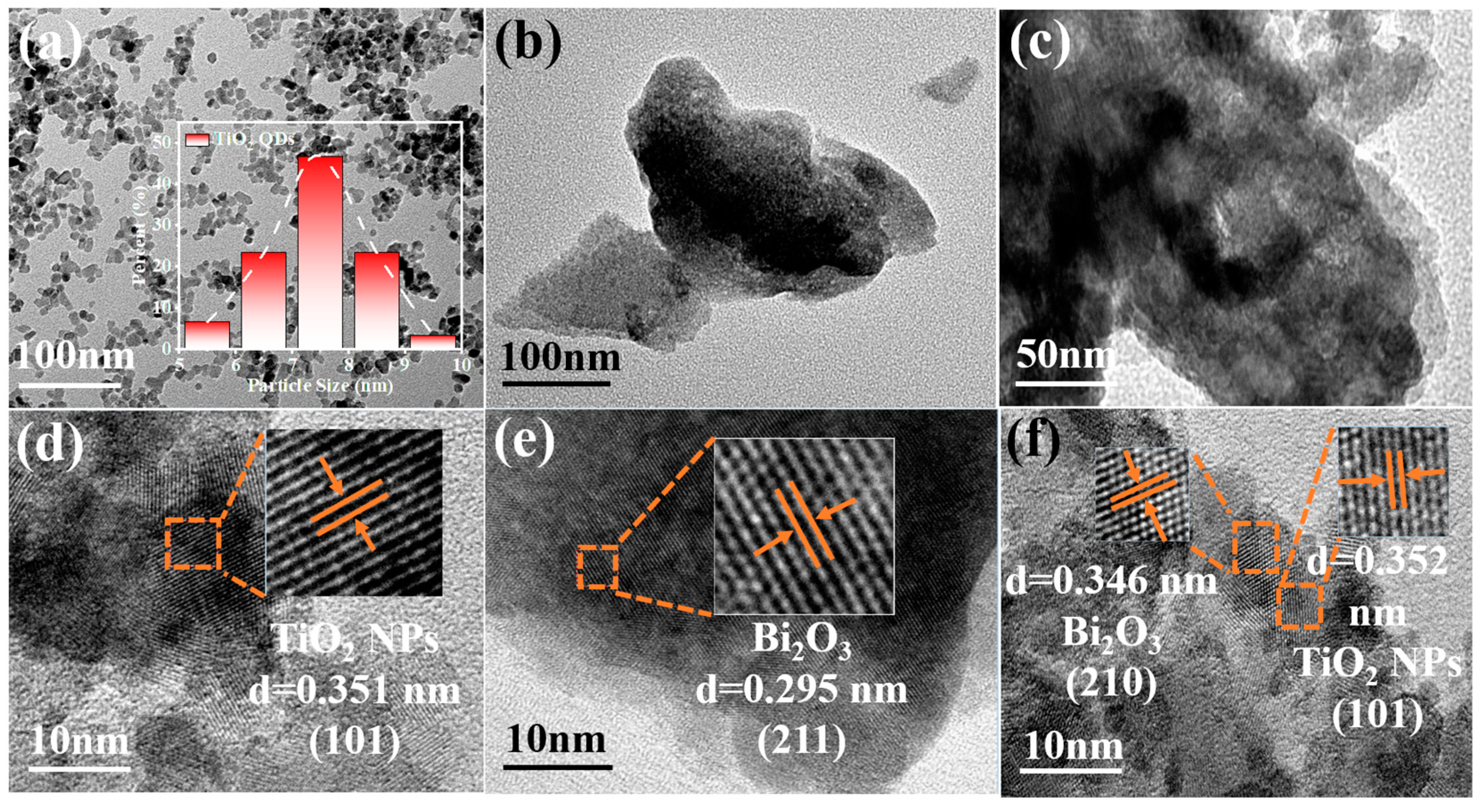
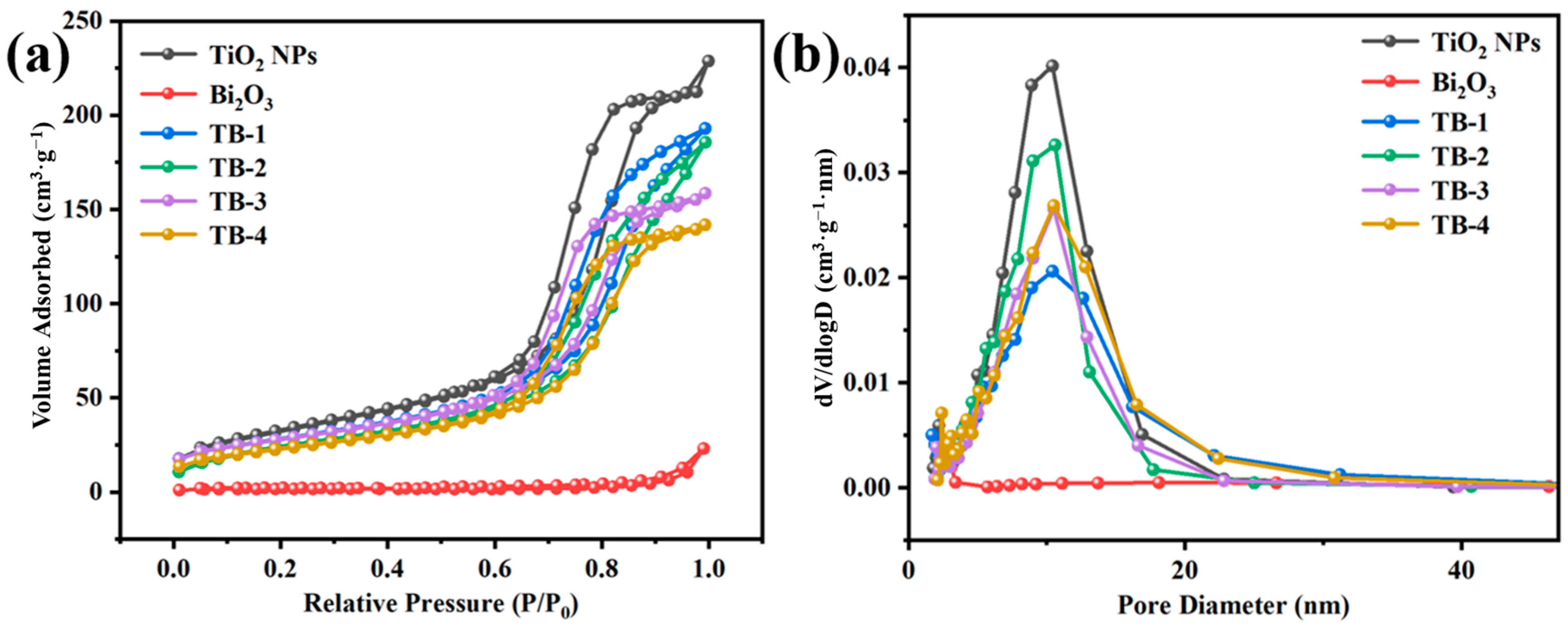
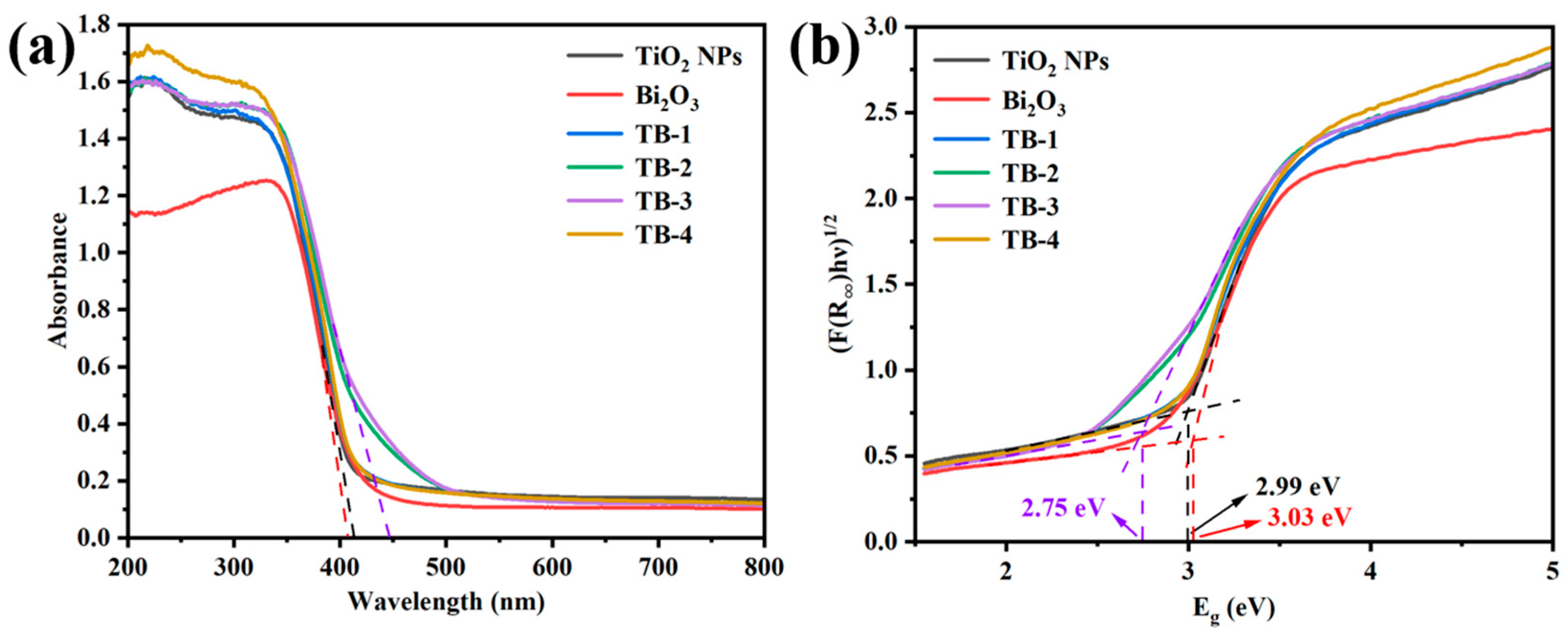

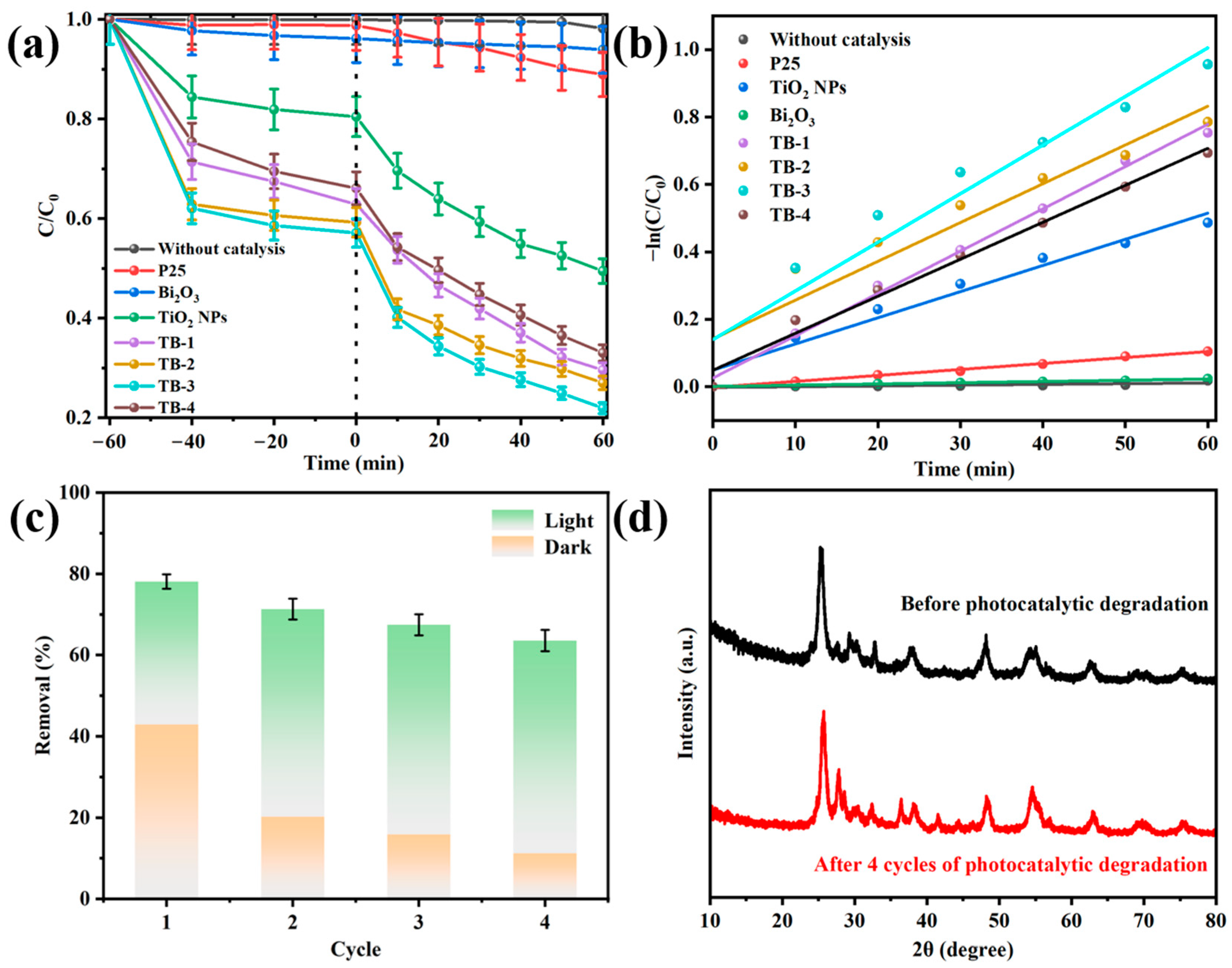
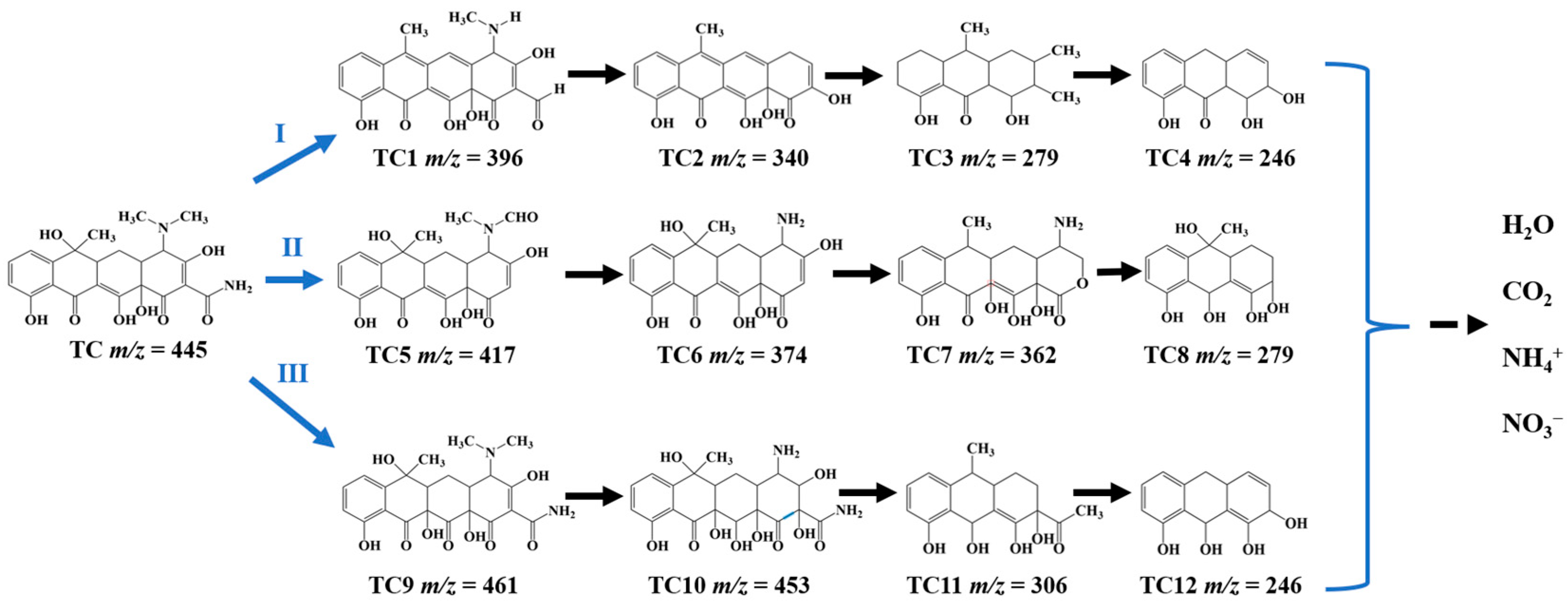
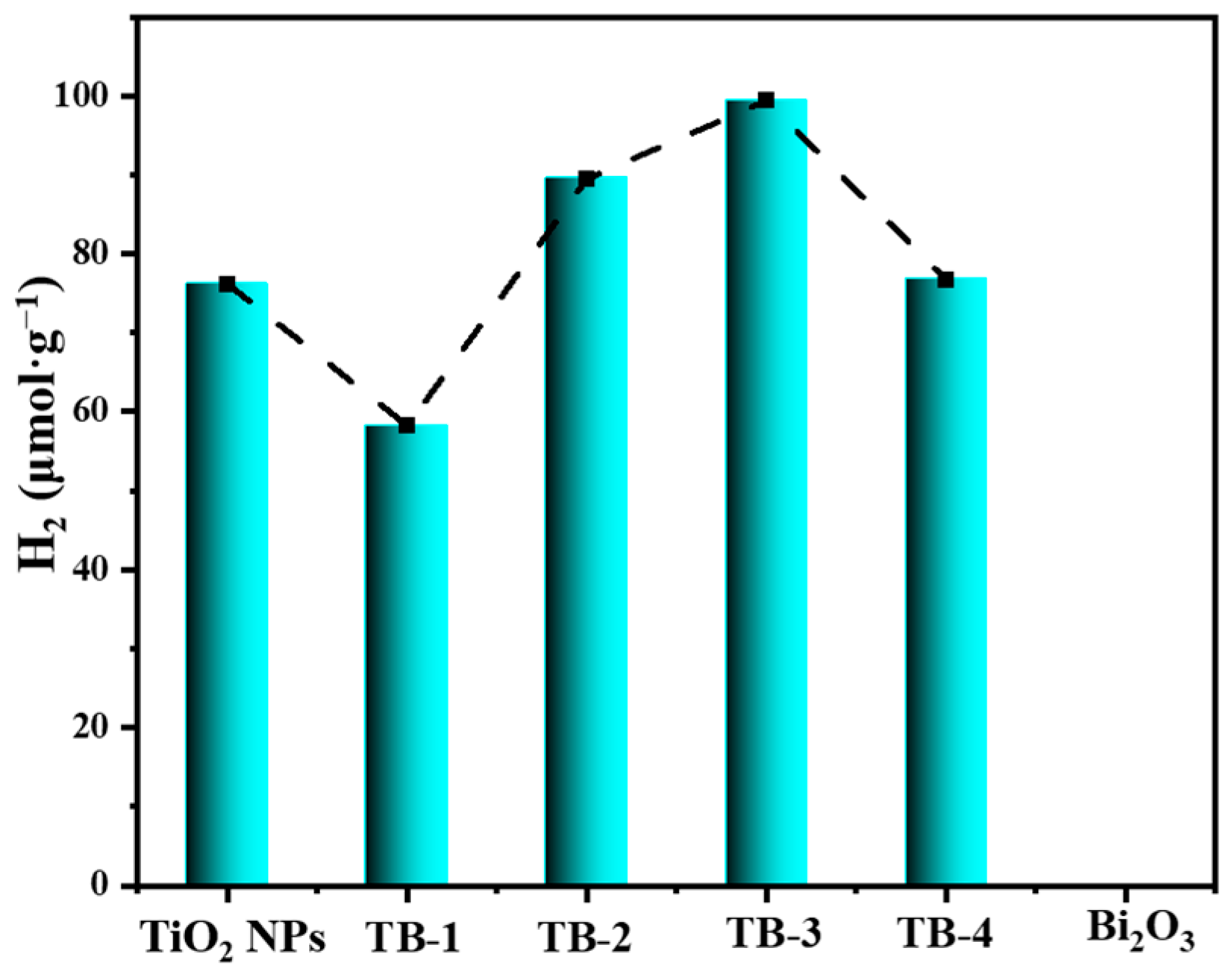

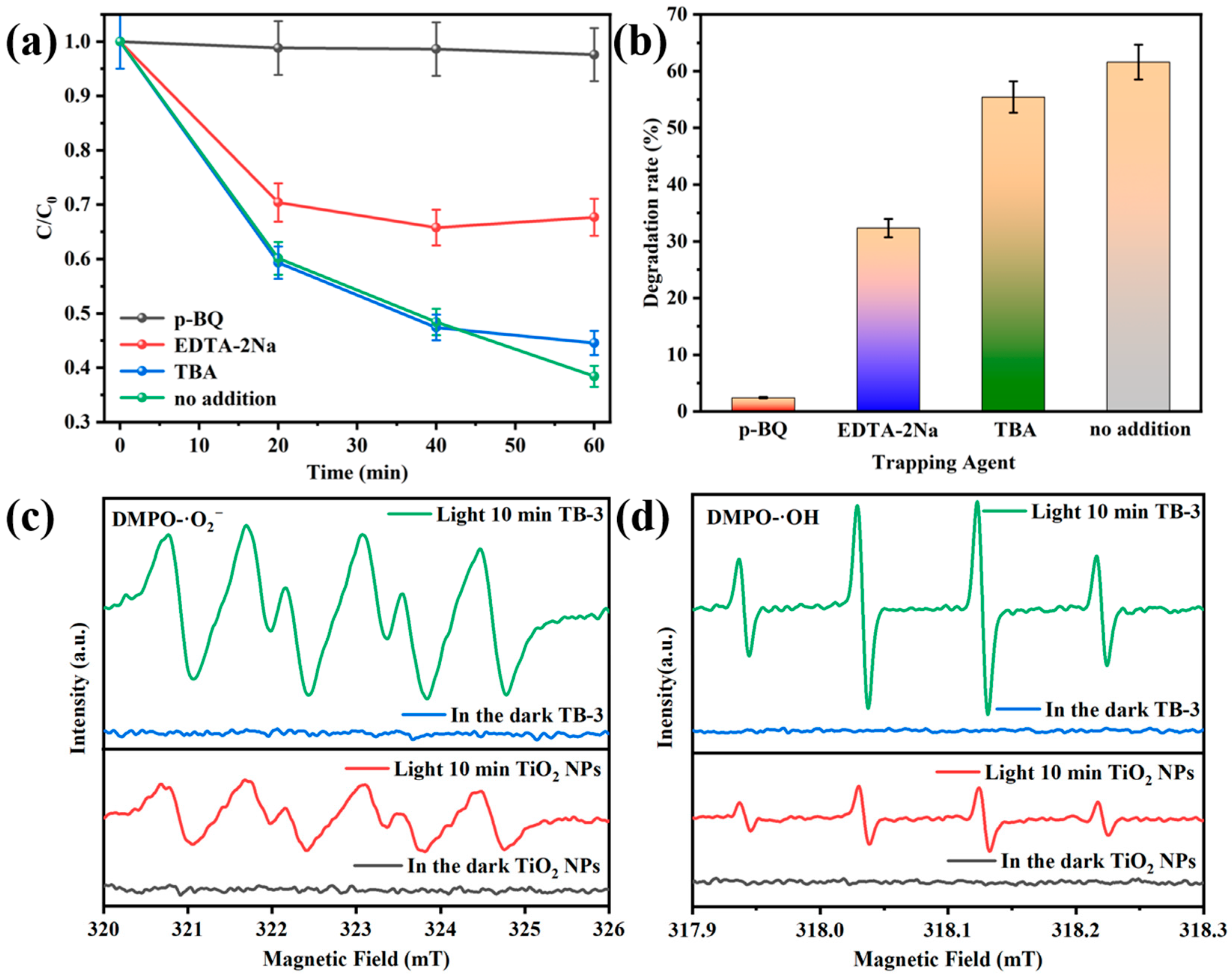


Disclaimer/Publisher’s Note: The statements, opinions and data contained in all publications are solely those of the individual author(s) and contributor(s) and not of MDPI and/or the editor(s). MDPI and/or the editor(s) disclaim responsibility for any injury to people or property resulting from any ideas, methods, instructions or products referred to in the content. |
© 2023 by the authors. Licensee MDPI, Basel, Switzerland. This article is an open access article distributed under the terms and conditions of the Creative Commons Attribution (CC BY) license (https://creativecommons.org/licenses/by/4.0/).
Share and Cite
Xie, L.; Wu, P.; Lei, Q.; Xu, C.; Huang, W.; Chen, X.; Yang, K.; He, H. Constructing Z-Scheme 0D/2D TiO2 Nanoparticles/Bi2O3 Nanosheet Heterojunctions with Enhanced Visible Light Induced Photocatalytic Antibiotics Degradation and Hydrogen Evolution. Catalysts 2023, 13, 583. https://doi.org/10.3390/catal13030583
Xie L, Wu P, Lei Q, Xu C, Huang W, Chen X, Yang K, He H. Constructing Z-Scheme 0D/2D TiO2 Nanoparticles/Bi2O3 Nanosheet Heterojunctions with Enhanced Visible Light Induced Photocatalytic Antibiotics Degradation and Hydrogen Evolution. Catalysts. 2023; 13(3):583. https://doi.org/10.3390/catal13030583
Chicago/Turabian StyleXie, Lijia, Piaopiao Wu, Qiong Lei, Chong Xu, Weiya Huang, Xunjun Chen, Kai Yang, and Hua He. 2023. "Constructing Z-Scheme 0D/2D TiO2 Nanoparticles/Bi2O3 Nanosheet Heterojunctions with Enhanced Visible Light Induced Photocatalytic Antibiotics Degradation and Hydrogen Evolution" Catalysts 13, no. 3: 583. https://doi.org/10.3390/catal13030583
APA StyleXie, L., Wu, P., Lei, Q., Xu, C., Huang, W., Chen, X., Yang, K., & He, H. (2023). Constructing Z-Scheme 0D/2D TiO2 Nanoparticles/Bi2O3 Nanosheet Heterojunctions with Enhanced Visible Light Induced Photocatalytic Antibiotics Degradation and Hydrogen Evolution. Catalysts, 13(3), 583. https://doi.org/10.3390/catal13030583







